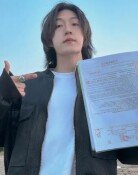Japanese mooks becomes barometer of Korean Wave popularity
Japanese mooks becomes barometer of Korean Wave popularity
Posted August. 04, 2014 09:25,
Japanese publisher Dokimeki Publishing was established in 2003 when Korean drama "Winter Sonata" first aired in Japan. A year after, the publisher released a Korean Wave mook (a non-regular publication between a magazine and book), emerging as a key Korean Wave publishing company in Japan. It has since issued Korean Wave mooks in various areas. However, Dokimeki began suffering since Korean-Japan relations cooled in 2012 and ultimately closed business in May this year.
Chiharu Izumi, Japanese literature professor at Seokyeong University, through her thesis "The Development and Features of Korean Wave through Japanese Mooks." said, "When Japanese people consume movies and dramas, they tend to simultaneously consume printing media. Mooks are a criteria for gauging the popularity of Korean Wave." When a Korean drama is scheduled for broadcast in Japan, various forms of mooks are released ranging from drama guidebook, making book, practice book, cartoons and to mobile phone novels. Her paper was presented at "Content Innovation for Hallyu 3.0," an international academic conference held in Busan Saturday to commemorate the opening of Hallyu Center at Korea University Research Institute for Korean Studies.
Dokimeki`s first mook was issued in April 2004 and was titled "I Love Korean Drama!," which covered Korean dramas centering on Winter Sonata actor Bae Yong-jun. The title was renamed "NEW I Love Korean Drama!" Since January this year, the mook started to be issued by a different publishing company and title was again changed to "I Love Korean Drama GOLD."
Since Korean drama "Daejangeum" was aired in Japan to drive the popularity of Korean historical dramas, a mook exclusively for historical dramas was launched in 2008 with a title "Korean Epic Drama King." A total of 23 editions have been issued until August 2012. With readers` interest diversifying, the mook started to cover the Korean culture overall, including sketching of the dramas` actual locations and introducing related traditional culture. When drama "You`re So Handsome" became a huge hit in 2011 in Japan, mooks like "New Generation Magazine" and "Hallyu Cafe" were published that introduced Korean actor Jang Geun-suk and young Korean Wave stars including K-pop stars. But these mooks lasted for just up to a year.
Korea-Japan relations soured since former President Lee Myung-bak visited Dokdo islets in 2012. Affected, Dokimeki has since been releasing mooks on Bae only. Professor Izumi said, "One of the reasons Korean Wave mooks declined is that Korean entertainment agencies blocked use of pictures of Korean actors and actresses citing portrait rights while demanding high guarantees, which led to worsening of mook production conditions," adding, "Since mooks partially drove Korea Wave popularity in Japan, there is a need to ease such activities."
The international conference was joined by some 20 scholars from various countries including Germany, Israel, Canada and Indonesia. Theses presented here included "Korean Wave Fans and the Islams in Indonesia," which claimed that Korean Wave is a common denominator between different religions and races; "Korean Wave and Japanese Wave: Can Popular Culture Exchange Open a Future" and "Korean Wave Drama`s anti-Japan Description and Response by Japanese Women and Female Korean Wave Fans," both of which said that anti-Korean Wave has developed into an anti-Korea sentiment.







